Exploring Cinema as Social Space: Communities, Encounters, Experiments
On 6 July 2024, we hosted a panel entitled Exploring Cinema as Social Space: Communities, Encounters, Experiments as part of the Cinema of Commoning Symposium. Below is an edited transcript of the conversation.
 Panellists from left: Djamila Grandits, Leyli Gafarova, Echo Xueden Tang, Jesse Gerard Mpango,
Panellists from left: Djamila Grandits, Leyli Gafarova, Echo Xueden Tang, Jesse Gerard Mpango,
Sarnt Utamachote (credit: Marvin Girbig).
A cinema of the commons is a place of collectivity and conviviality. Cinema should be an “agora” where people come together not only to watch films, but to engage in discourse and dialogue, living, working and (un-)learning together. A cinema that sees itself as a social place is committed to local and international communities, encouraging access, discussion, education and alternative ways of organizing. Yet, though it sounds simple, this work can sometimes be challenging. How can we develop equitable and inclusive programs which involve diverse audiences? How do cinemas create political engagement and collectivity? What discursive, artistic and social forms of exchange and encounter constitute a cinema of the commons? Taking these questions as its point of departure, this panel will focus on the experiences and know-how of cinema initiatives that foster safe(r) shared spaces through participation and solidarity.
Leyli Gafarova, Salaam Cinema (Baku, Azerbaijan)
Jesse Gerard Mpango, Ajabu Ajabu (Dar es Salaam, Tanzania)
Sarnt Utamachote, filmmaker/curator (Berlin, Germany)
Echo Xueden Tang, CiLENS (Berlin, Germany)
Moderation: Djamila Grandits, film curator (Vienna, Austria)
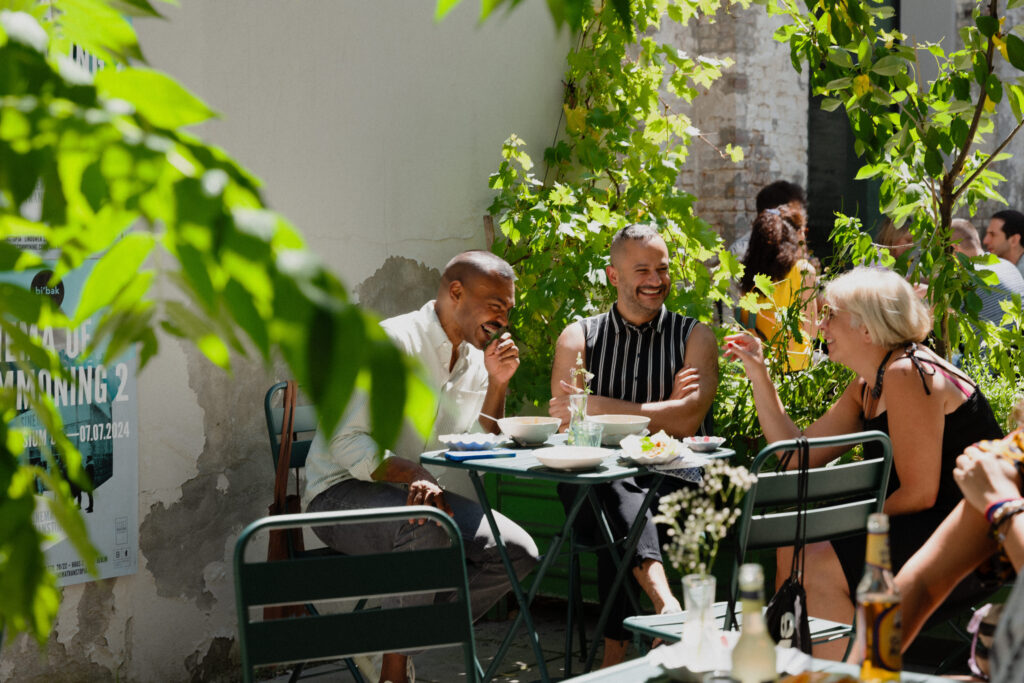 The SİNEMA TRANSTOPIA garden during the Cinema of Commoning Symposium (credit: Marvin Girbig).
The SİNEMA TRANSTOPIA garden during the Cinema of Commoning Symposium (credit: Marvin Girbig).
Djamila Grandits: Processes of negotiation are key to all collective work, but one recurring theme in our conversations is the question of what happens when you are on verge, when you must decide whether to remain a grassroots organization or transition into becoming an institution. This raises the question of how we negotiate our relationship with the outside world, and forces us to reconsider what it means to be part of the cultural sector, to reflect on our original motivation for beginning this work. Discussions about formal inventiveness are not just conceptual but also practical; new formats often emerge from negotiating new constellations. It reminds me of what Stavros Stavrides was saying yesterday in his keynote, that we are rehearsing possibilities together.
The topic of team structures and how to organize ourselves collectively comes up a lot: how do we navigate fluctuations and precarities? Our positionality operates on many levels–the relationship with the audience, the immediate neighborhood, the industry and the broader cultural field, both locally and internationally, as we discussed in the Building Alternative Cinema Networks panel yesterday. There’s also our connection to the online community, especially in the aftermath of the 2020 Covid pandemic, which was highlighted earlier today in the Cinema as an Embodied Space panel. From what you’ve described, it seems like much of your practice emerges from your relationships with the immediate environment. Whether it’s moving through a city or reclaiming spaces, I’m curious about how you build relationships with your audiences. For instance, who attends the activities you organize at Salaam Cinema, and how do you develop a relationship with your audience?
Leyli Gafarova (Salaam Cinema): Over the past five years, our audience has changed quite a lot, I don’t always know where they come from. From the beginning, even before the doors were open, people were already coming, eager to contribute, which underlines the fact that there was a need for a space like ours. Some people identify us as a queer space, but we find that term problematic because it’s quite specialized and raises questions about how people choose to self-identify. We prefer radical inclusivity, welcoming everyone regardless of how they identify. But it’s also a safe space, so inclusivity ends when safety is under question.
We host many community events and celebrate some traditional holidays like Nowruz, the Persian New Year. We’re located in a central but edgy location, near the main train station, and at the same time in a somewhat conservative neighborhood. Our audience has become quite diverse, bringing people together from the neighborhood and the queer community. In that sense, it’s a kind of experiment in coexistence, where people are empowered to be themselves. We do Ramadan iftars, which also provides an entry point for the local community to support us.
However, there are compromises. We have managed to maintain a good relationship with the police, which is rare in Azerbaijan, a country with very unbalanced power dynamics with law enforcement. Last week, for example, we hosted a breakdance event downstairs while a queer event was happening upstairs. We have a neighbor who always calls the police–it’s a tradition by now! Every summer, she calls the authorities because we move our activities outside, and eventually, the police get fed up with her calls. We’re proud that we’ve never bribed the police, which is also very unusual in Azerbaijan. Normally, whether you run a club or a cafe, you have to pay the police to leave you alone, but we have never done this, and we’re proud of that! But on this occasion, when the police came and said they would fine us, we didn’t argue with them on moral grounds the way we normally would. We knew that a group of queer people were about to come out from upstairs, which would likely escalate the problem. So we compromised our tradition of not paying bribes, on this one occasion, for the good of the community.
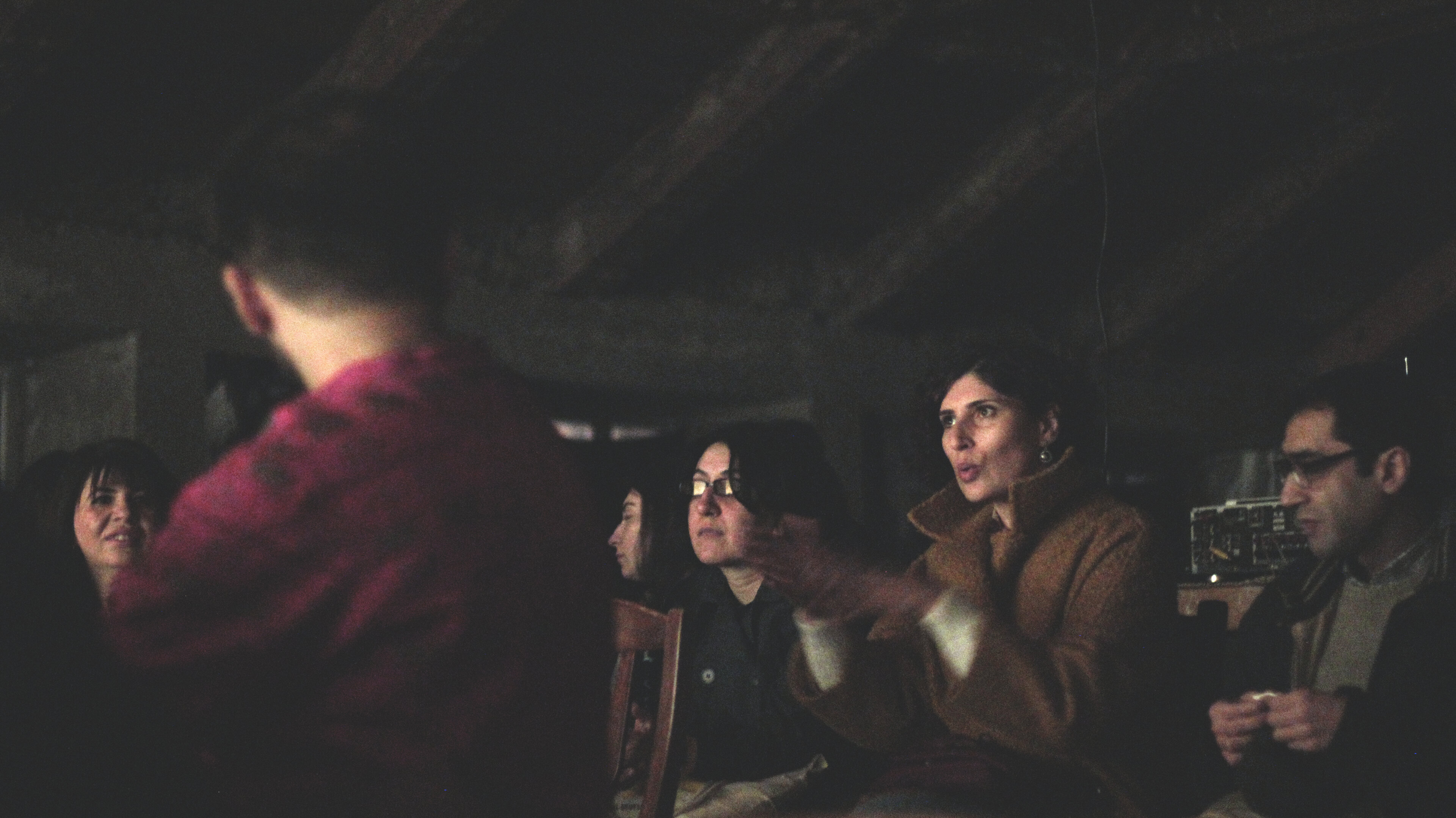 An audience gathered for a screening at Salaam Cinema in Baku.
An audience gathered for a screening at Salaam Cinema in Baku.
Djamila: Thank you for sharing that story. It’s such a tangible example of what it means to negotiate in real terms, especially around the idea of “safe spaces.” What defines a queer space, and what does it mean to practice radical inclusivity while staying true to the rules we’ve set for ourselves? The situation you described illustrates that beautifully.
Echo, I’d love you to pick up this idea about relationships with audiences and speak about how you’ve developed your local and transnational connections, as your festival has grown over time? How did you first begin engaging with potential audiences?
Echo Xueden Tang (CiLENS): Thank you for the question! Maybe I can start by giving a bit of context. I moved to Berlin in 2021, after receiving a fellowship from the Humboldt Foundation. The funding environment has changed since then, but I was lucky to have that year-long support. Each fellow needed to pursue a project, which would be wrapped up with a report at the end.
The fellowship was focused on research-based projects, but I turned it into a practice-based project. After a few months of reading, thinking and observing this new city, I started organizing very modest film screenings, which eventually became the first CiLENS events, although we operated under a different name at the time. These screenings took place in a small, temporary space at Haus der Statistik, in a room with about 50 plastic chairs that we set up ourselves. That’s how it all began.
The first event featured a documentary screening, and during the two months I spent preparing, I began to find or create my community. I didn’t know anyone in Berlin, so I started reaching out to people, posting everywhere, asking, “Hey, I want to do this! Does anyone want to volunteer?” That was the first time I started meeting people. About 56 people showed up, even though it was all word of mouth at that point. Through their donations, I managed to cover the license fee and material costs. To this day, CiLENS continues to function this way. While public funding is great when we have it, we often collaborate with institutions like SİNEMA TRANSTOPIA, or we keep production costs very low. Our events are donation-based, and everyone volunteers
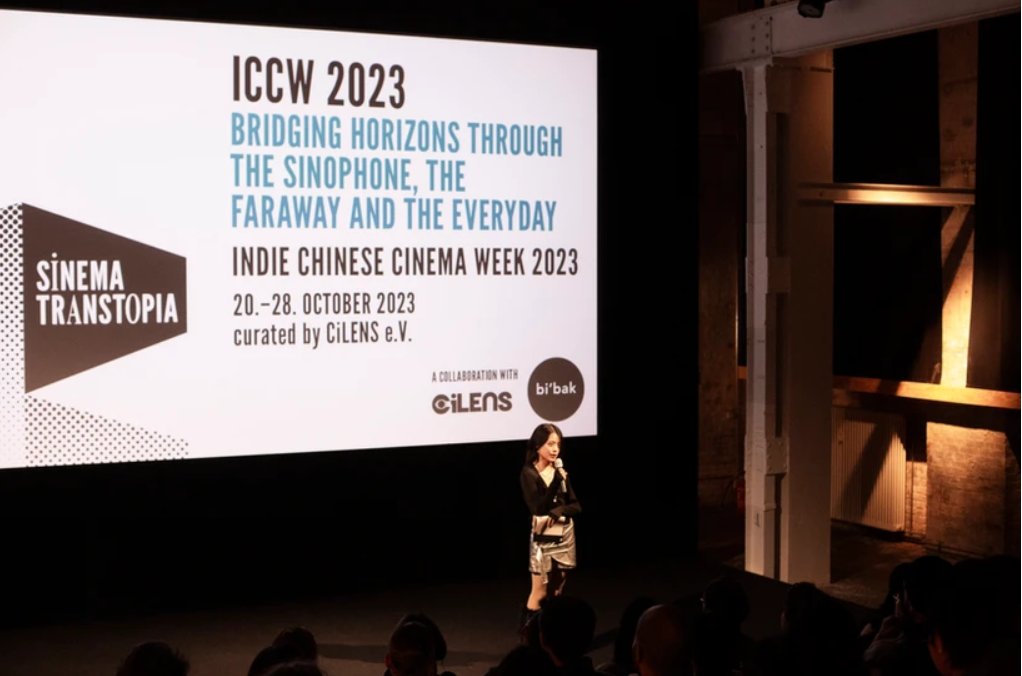 Echo introduces a screening at SİNEMA TRANSTOPIA as part of Indie Chinese Cinema Week.
Echo introduces a screening at SİNEMA TRANSTOPIA as part of Indie Chinese Cinema Week.
As CiLENS grew, I began curating thematic programs like New Woman, New Narrative, or another one on Asian queer cinema. We became more intentional about identifying where audiences might come from and how to reach them, especially here in Berlin. I started using practical tactics, like talking to people at gallery openings and pitching our events. I also try to create a dialogue through my curation so that when people attend our screenings, it’s not just about watching a film and leave–it becomes an experience. People know that when they come to our events, they will meet others they might want to connect with, and the panel discussions will usually explore a really interesting theme, like LGBTQI+ campaigns in China over the past 20 years, for example.
We also try to find connections that are transnational, such as feminist themes. We look for points of connections, for instance certain activists or communities might be interested in the development of a queer space in an East Asian context and vice versa. Ultimately, understanding others leads to a deeper understanding of ourselves.
Another important focus for us in terms of content is migration. For example, during the first edition of the Indie Chinese Film Festival at SİNEMA TRANSTOPIA, we screened Ants Dynamics, a documentary about social intervention in China where artists helped retired telecom workers fight for their unpaid pensions. The situation got worse and worse, and this group of artists intervened and started making documentaries and organizing art protest campaigns in the city, which attracted the police and led to lots of negotiations within institutions and on the street. This was all documented in the film, which was screened once in China before being shut down, so it was particularly meaningful to show it in Berlin.
We held the screening in the afternoon, followed by a Zoom discussion, during which I translated between Chinese and English. The event was packed, and I always find it fascinating to observe the audiences and ask them how they came to be here. These screenings tend to attract people studying Politics or who have an interest in Asian queer cinema. One evening, we featured two documentaries of lesbian histories in China and Korea. Before the screening, I reached out to specific communities and individuals involved in Berlin-based or European-based initiatives. After the screening, there’s usually a formal discussion, followed by informal conversations. People linger here or at the bar, and we often walk home together, continuing to discuss the topics that emerged from the film. For me, this remains an ongoing process of negotiating and co-creating our relationship with the audience.
 A post screening discussion at a CiLENS event.
A post screening discussion at a CiLENS event.
Of course, it’s not all positive. I remember an argument at the first film festival when we showed a film by a respected Tibetan filmmaker. He expressed this support, and I was also friends with the two founders of the Berlin Tibetan Film Festival, who I had met at SİNEMA TRANSTOPIA. But the fact that we were showing a Tibetan film, which holds significance for the Tibetan diaspora, sparked controversy. There was an open letter directed at the film festival, saying people didn’t think we had the right to represent the film. I spent two days trying to figure out how to respond. In the end, I read the open letter to the audiences, and after the screening, wrote back stating my point of view.
We also had an audience member complain that the screenings never started on time because people weres buying beer or going to the toilet, and there was always a five-minute conversation at the beginning. She didn’t get it and posted in the largest online Chinese community group in Berlin, where I am an active member. I replied, explaining that this is a non-commercial theater and that this is how I understand community. But it sparked a huge discussion about the dynamic between institutions and the individuals, who has the loudest voice and so on. So, of course, it’s not always good things happening–not always full houses and great conversations.
Djamila: It’s also important to think about how discourse travels from the cinema space, into the foyer, into online spaces and then circulates back into the space. Often, it’s in these meta-discourses that relationships to power and sociality are negotiated. Your experience demonstrates how naturally messy, sticky and conflicted sociality is. There’s always the potential that someone might say, “I don’t like this film, but I will come back tomorrow,” which is something we heard in the panel yesterday about Embodied Cinema. What’s crucial in what you just shared is how curatorial work is heavily bound to organizational work. What does it mean to reach across demographics and to construct a community around it that is never homogenous and will never be representative, but which is still, I think, crucial to diaspora in practice? There will always be messy entanglements, yet these groupings can somehow work.
I want to bring you in here, Sarnt, because we were discussing navigating between different spaces–approaching various contexts and institutions with different practices, maybe explicitly activist in one, while in another, an exhibition practice in an established institution, and elsewhere, a community-based film festival. What does it mean to move between these different forms of expressions, codes and languages? How do these different audiences change the way we express ourselves?
 A workshop as part of Wandering Salon, unthaitled x KAUM Film+++festival 2023.
A workshop as part of Wandering Salon, unthaitled x KAUM Film+++festival 2023.
Sarnt Utamachote: Linking to what Echo said earlier, I think we are missing the term “political communities” in our discussion somehow. For a long time, I have fought against the idea of random inclusion. Museums often say they want to welcome migrant communities, but I don’t welcome fascist migrants, for instance. My national community also includes fascists, but I don’t want to bring those people to my screenings. In other programs, I intervene because I think I have some understanding of these migrant demographics, at least in Berlin.
For example, once during a period of archive research, I found an old Vietnamese film from the 1980s in a German museum collection in Wiesbaden. I sent an image to a Vietnamese friend and their parents recognised it. So we organized a screening here, and an older generation came, people who were part of the so-called contract workers who came to East Germany. The film connected to that history. In the past, a lot of Vietnamese cinema was shown in East Germany because of the connections between socialist countries. It’s a good example of how screening archival work in cinemas can actually bring an older generation through the door, people who often miss out in the English-dominated world.
Another example relates both to class and the queer scene. I made a documentary, I Don’t Want To Be Just a Memory, which premiered in Forum Expanded at the Berlinale in 2024. The film was about my queer party friends. We collaborated to memorialize a friend of ours who had died due to mental health issues and a drug overdose. In that process, it became part of a film program at XPOSED and some other collaborations with the party scene. We understood that not everyone can afford the ticket, and not everyone feels comfortable to even come to a formal space. In this case, my role as curator also involved making people feel comfortable, introducing everyone to each other. It required a lot of mental work and deep engagement. These are just two examples of how we might need to go deeper in engaging audiences.
Djamila: Yes, thank you for pointing out how intimidating and unwelcoming formalized spaces can be. Certain codes might prevent some audiences from ever entering a discursive world. At the same time, that world is always drawing from physical, lived realities and translating them into abstractions. How can we translate the abstract back into ways of being that bring us closer to each other?
Jesse, maybe that’s a nice jumping off point for discussing the different aspects of your work. You create audiences, you’ve moved into the city and you have a legitimate space. But you also engage with semi-formal, semi-legal practices of audience engagement, using local practices to revive African archive cinema for new audiences. Could you elaborate a little bit on one of those practices–dubbing? What is this, and how does this alternative approach help you build and sustain audiences?
Jesse Gerard Mpango (Ajabu Ajabu): Dubbing tends to get the most attention, but actually it’s just one element of a larger ecosystem. There are people who run film libraries, sell flash drives or DVDs and operate small cinemas that screen films 14 or 16 hours a day, often serving people with nowhere else to go. Our relationship with these spaces is definitely one of learning. We are collaborators, we both have a shared interest in new strategies and models for how film circulates. Who gets to own it? Who gets to comment on it?
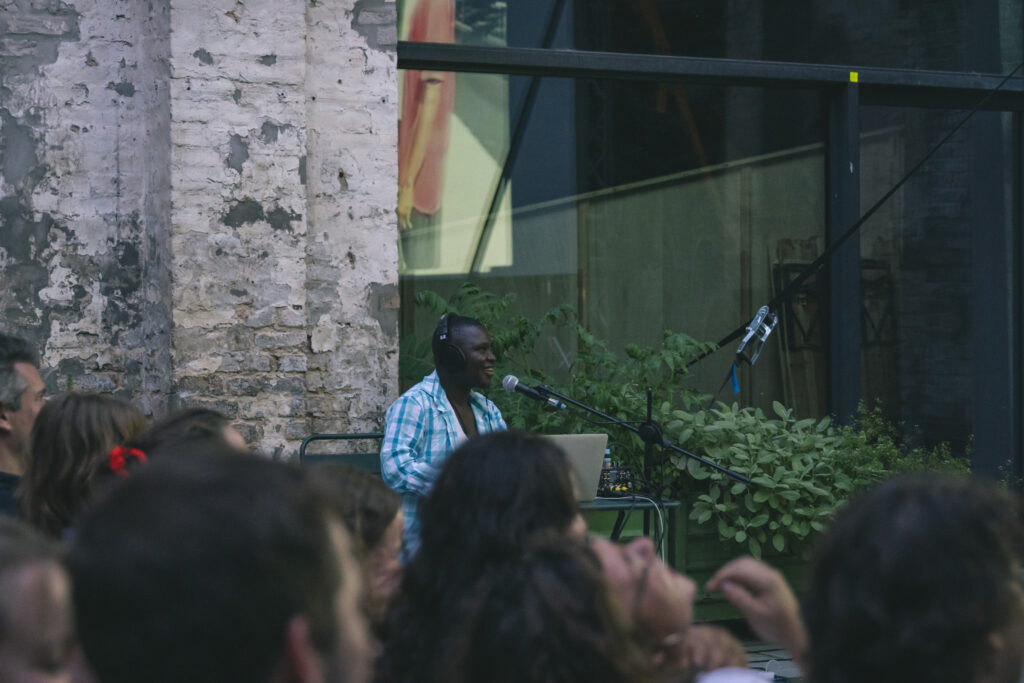 DJ Black live dubs a screening as part of the Cinema of Commoning Symposium (credit Lucía Alfaro).
DJ Black live dubs a screening as part of the Cinema of Commoning Symposium (credit Lucía Alfaro).
At the moment, if you look at material reality, Ajabu Ajabu is a failed entity–a phantom business. Words like “sustainability” get thrown around, but the reality is, what we do cannot be sustained. Look at the cost of film rights compared to our exchange rate in Tanzania. You would have to sell Sembène like The Avengers just to break even. It makes no sense. So with that shared understanding of the nonsensical global environment, it becomes clear that we need to remove some of the loaded language and legalities which make our work invisible.
The dubbing artist DJ Black, who was the subject of our documentary Apostles of Cinema, was part of a long-term research project around the strategies of these environments. His work is not just translation–it’s reinterpretation, re-situating these films away from the global industrial order. He allows these films to be re-situated within different localities, with a language and aesthetic that is non-existent in that world order. On the flip side, African cinema is rarely screened in Dar es Salaam because distributors claim there are no cinemas. Maybe there are no cinemas which look like the ones you see as legitimate in western European and US contexts, but there are cinemas. So many cinemas. They just take different forms.
When it comes to audiences, we are taking a long-term view. There is a convergence between the films being produced now–which are telling specific, international stories about realities which are not part of dominant narratives–and the treasure trove of an African canon that’s doing the same thing. When these come together in real communal spaces that serve their communities, our work becomes a bit more secure and a bit less precarious. Then we also don’t have to continue this farce of pretending that we play a part within a commercial framework which really doesn’t recognise us at all, which is only interested in our commercial value and ability to keep moving in that direction.
 A still taken from Apostles of Cinema.
A still taken from Apostles of Cinema.
Dar es Salaam is a huge city. It takes two hours plus, depending on traffic, to get from where we are based in Mikocheni to Buguruni, which is DJ Black’s neighborhood. The expectation that we could pull in audiences beyond our own area is unrealistic, but what we can do is be agile and mobile. That is why we’re kind of anti-formal, because we want to be able to pick up and reframe our work in different ways. There’s consistency in the way we approach audiences. We don’t change the way we talk about our work depending on the space–we always connect with our immediate surroundings. We aim to respect the work of spaces perceived as being on the margins, which are not usually considered spaces of discourse, but which carry the history of people’s relationship with film, video and visual culture. That history exists in those spaces because they’re the most active and participatory. These are spaces where people are able to express themselves, which have a capacity for memory that goes beyond national institutions. They produce an environment that speaks more truthfully to what a cinematic experience in Dar Es Salaam might be. We’re still experimenting to see what is possible, but it’s a long journey which requires a lot of organization, relationship building and negotiation. Nevertheless, there are moments when a simple conversation or a well-chosen film can spark larger questions and subvert agendas which otherwise feel pervasive. Those moments keep us going!
Sarnt: I just want to jump in here–I was talking to DJ Black yesterday and asked if he had ever dubbed Titanic. Imagine if SİNEMA TRANSTOPIA showed Titanic with a DJ Black dub–I’d be so here for that! It’s a perfect example. Titanic would never play at SİNEMA TRANSTOPIA , but if you can subvert it and claim it as yours, then it becomes something for you and your people.
Djamila: Totally! It also makes me think a lot about ownership–who owns different genres? And all those cinematic expressions you talked about: the popular, the independent, the historical. When suddenly those hierarchies are suspended, it’s about creating collective ownership. I would like to open to audience questions now.
 Audience members gather in the bar of SİNEMA TRANSTOPIA for a CiLENS screening.
Audience members gather in the bar of SİNEMA TRANSTOPIA for a CiLENS screening.
Audience Question: Thank you all very much. I appreciate how you discussed the contrast between how the Global South operates and how diasporas operates in Western contexts. As an anthropologist of media, I find the rawness of the compromises you mentioned refreshing. The global economy, including independent media, often exploits stories from the Global South without considering how those narratives come back to us.
I wanted to ask Echo and Sarnt how you navigate formerly subcultural topics that have now become almost mainstream. Many films, for instance, are addressing ideas around feminism and queerness, which are now more widely accepted, yet there is less discussion about modes of production, aesthetics and dimensions beyond this thematic engagement. What’s your experience? How do you see those films which reshape or destabilize normative aesthetics, or the usual modes of production and circulation? And to flip it around, how do you navigate the economic infrastructure in your local context? I understand that you might need to compromise in order to operate, but can you somehow hijack national or governmental resources to get these more challenging films seen?
Echo: Thank you for your question. If I understood correctly, you’re asking how some of the films we showcase can be seen as examples of alternative film production, given the fact that many filmmakers are engaged in activism or other alternative forms of art. Our conversations flow freely, with audiences questions often exploring both the topics of the films and the logistics of their production–how projects were completed and the challenges faced by their makers. As we develop, there’s also growth. A growing number of our audience members now come from filmmaker communities we’ve interacted with, such as the Berlin Asian Film Network.
The films we screen, particularly documentaries, are really good examples of alternative production. There’s one, for example, called We Were Smart, which is available online for free. This film showcases a new way of distribution. The filmmaker received a little sponsorship from an art museum to make the film, but it was also a super low-cost production, so he chose to put it online for everyone to watch to make it more socially engaging.
 A still from We Were Smart (Li Yifan, 2019).
A still from We Were Smart (Li Yifan, 2019).
It was the opening film of a program I curated last year, called From the Margins of China. This documentary is about the lives of migrant workers who move from the countryside to big cities in China and end up working in factories. Around 15 years ago, these economic migrants developed this very particular strong visual aesthetic and lifestyle called “Smart”, characterized by a distinctive visual style–super colorful, long hair, extravagant style. That aesthetic has developed into a very influential nationwide subculture and it’s a super interesting documentary. So after we screened the film, we saw that people were sticking around and some were really emotional, so I came over and shared more information about how the documentary was made. The director asked everyone still working in the factory to use their phone to secretly capture footage. He interviewed maybe five or six people who were still willing to share their stories, because some of them had been physically abused due to their association with this subculture. This was a very good example of alternative film production and I shared that information after the screening, so the audience might understand that very specific context.
Sarnt: To pick up on that question of how production links to audiences and distribution, this is a big discussion we are constantly having at XPOSED. We deeply research every film we select, and we have very specific categories. It’s not just “queer”, but it’s also lesbian, gay, intersex, sex worker, disabled, neurodivergent, which creates a kind of micro-sector under every word. We try to understand how the film was made. For instance, is a story about a disabled person also created by a disabled filmmaker? I find it particularly intriguing when a queer filmmaker portrays straight characters—this is a personal favorite! I’ve been saying for a long time that I’m really curious about queer cinema which is not about queer people! I think it’s important to keep having this conversation.
I stirred some controversy at Film Fest Dresden when I was on a panel, when I said that I would not program Russian films now because of the war in Ukraine. This is also partly an act of solidarity with our Ukrainian colleagues at XPOSED, who are not happy about Russian films being shown. The point is that it’s not about canceling; it’s about acknowledging the current political context in which we operate. Nevertheless, at XPOSED this year we did show one Russian film, Queendom, which focuses on the Russian drag artist Jenna Marvin who has been exiled from Russia. Many Ukrainian people came to that screening and all expressed solidarity as well. There are always exceptions.
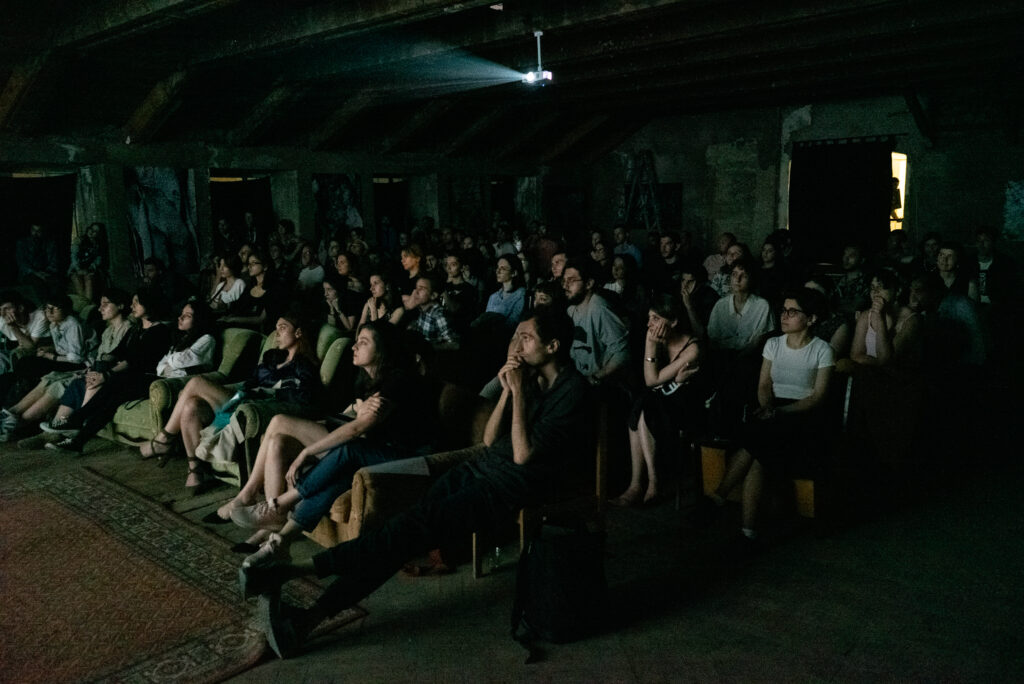 A screening at Salaam Cinema.
A screening at Salaam Cinema.
Djamila: Jesse and Leyli – would you like to address the question about the economic ecosystems in which you are situated and what it means to work within these restrictions?
Leyli: Our situation is quite interesting. In Azerbaijan, state funding often means state control. In our case, the best way the state can support us is by not interfering. So at the moment, we feel very supported because they do not interfere! The second problem is that the Western subsidies that are available also have a particular agenda, perhaps around LGBTQI+ rights or women’s rights. The Azerbaijani government restricts access to foreign grants, because they view them as means of spreading Western values. Although when you look closer, these are fundamentally basic human rights.
We have sometimes received international funding, but it’s limited and never institutional–it’s always project-based. This creates a survival mechanism for us. We’re lucky that we don’t pay rent, which allows us to remain non-commercial. But we do realize that we’re going to have to consider how we keep moving forward because we don’t want to just survive. We are trying to work out how to create a structure where the work feels dignified and is appreciated, but is also still accessible for everyone. I don’t have a ready answer.
Jesse: So much of what you said resonates, particularly the part about the state. We’re very well supported as well, they just leave us alone too! But there is no public funding. All the state entities around culture are policing and enforcing censorship mechanisms. They also very much jump on the bandwagon if something goes well, especially if you make money. Suddenly they’re all there and they’re supporting you. They’ll be at the airport to applaud a pop star who got nominated for an award or something. There’s always an adjacency to the monetary potential of culture, that is the only kind of investment they’re interested in.
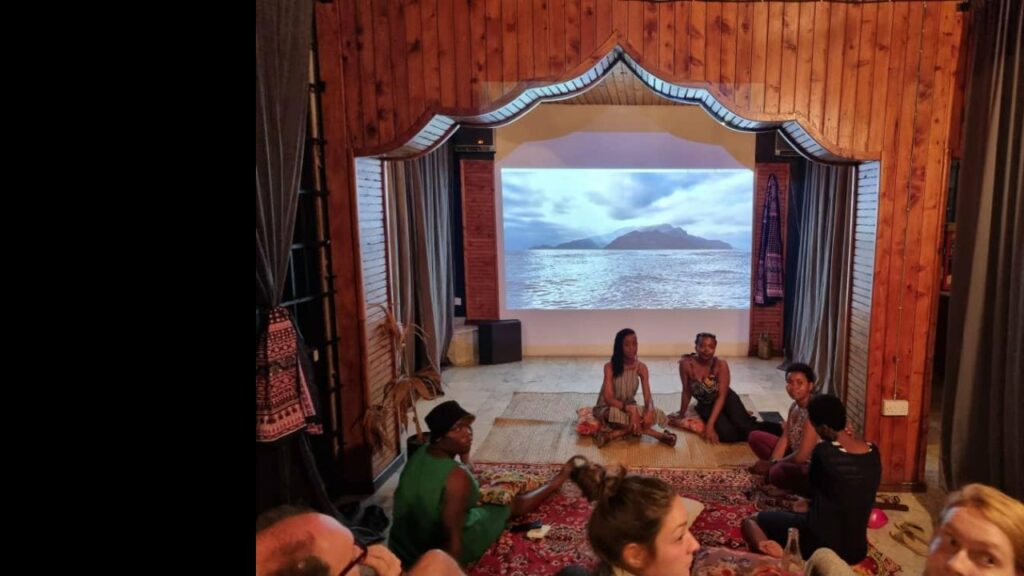 Mama Mishe Film Program, Dar Es Salaam, 2022 (credit Ajabu Ajabu).
Mama Mishe Film Program, Dar Es Salaam, 2022 (credit Ajabu Ajabu).
At Ajabu Ajabu, our funding is project to project, and the majority of it is international. So I listened with interest to the keynote from Sinthujan Varatharajah, which highlighted how these international funds might be further embedding systematic issues and traumas. But I’m also not crazy about those who are already taking on the labor of navigating the reality of these funding systems, also being tasked with finding the solution. As people who are organizing and creating spaces for conversations and trying to retool the discourse, our act of commandeering is also sort of making the case for a more equal relationship with funding bodies. Our model is not focused on individuals, or even specific institutions and frameworks. The way that we’ve managed to hijack the system is by not having those formal frameworks, even though we do have internal conversations about who is taking the lead.
All the funding is for Ajabu Ajabu and I don’t think our funders even know exactly who that is, they just trust in the collective. That is a massive development from even a few years ago, when it was all about the individual: the star director, the star institution. That focus really ends up sucking up all the air and creating a gatekeeping situation. It’s not ideal, because our funding does still come from elsewhere. But I also think that the labor of finding lasting solutions to this broken and fractured system should not be outsourced to those working in vulnerable situations. We do what we can. I don’t want to romanticize it at all, because if you’re working at an institution, you get a secure job, a monthly salary, sometimes, insurance, all of these things. You can think across multiple years. Those are privileges that we don’t necessarily have. But I think it’s necessary to really be able to think in pluralities like collectives, and to broaden and contract according to the moment you’re working within. To not just inherit a framework because that is what is considered the norm in another context.
Djamila: Thank you for wrapping up with the ambiguity we experience when we, as individuals, work within these shape-shifting entities. The process of commodification is inescapable, as we know, but I think one way to hijack and support each other through this is to form these alliances. Thank you for this very dense and beautiful conversation.
 Panellists from left Djamila Grandits, Echo Xueden Tang, Jesse Gerard Mpango, Sarnt Utamachote (credit: Marvin Girbig).
Panellists from left Djamila Grandits, Echo Xueden Tang, Jesse Gerard Mpango, Sarnt Utamachote (credit: Marvin Girbig).
Leyli Gafarova is an independent filmmaker, researcher, educator, and co-creator of Salaam Cinema, a community-based cinema and art space. Based in Baku, she focuses on processes, research, and discoveries, through the lens of themes such as gender, national identity, (self)-censorship, and co-existence. Leyli employs participatory approaches and games to experiment with authorship and collectivity, while also reflecting on and questioning production processes. Additionally, she curates film programs, educational labs, and festivals to examine and deepen the understanding of suppressed voices, identities, and narratives.
Xuedan Tang (Echo) is a Berlin-based film curator and cultural producer from Chengdu, China. She founded CiLENS and Indie Chinese Cinema Week (ICCW) in 2022, projects that reflect her multifaceted interests and ongoing research in cinema, feminism, and socially engaged practice.
Jesse Gerard Mpango is a storyteller from Kasulu, Tanzania. He is a founding member of Ajabu Ajabu, a multimedia curatorial collective based in Dar Es Salaam. The collective uses participatory, open-ended approaches in its programming and events to explore de-centralized and communal forms of presentation, production and preservation of audiovisual work in Tanzania. Recurrent within his work as part of Ajabu Ajabu, and as an independent practitioner, is the capacity for participatory rituals of imagining to unsettle and dislocate dominant narratives and extractive power structures.
Sarnt Utamachote is a Southeast Asian nonbinary filmmaker and curator based in Berlin. They view cinema as a tool for social engagement and collective healing. They are a co-founder of un.thai.tled, an artist collective from the German-Thai diaspora, and have curated multiple research-based exhibitions concerning postcolonial histories, the Southeast Asian diaspora, and activism in divided Germany (GDR/FRG). They work as a film programmer at XPOSED Queer Film Festival Berlin, Hamburg International Short Film Festival, and at SİNEMA TRANSTOPIA.
Djamila Grandits is a curator based in Vienna. As part of CineCollective, she directs Kaleidoskop Film and Freiluft am Karlsplatz. She is part of the pre-selection for Berlinale Panorama and a member of Zurich Film Foundation’s non-fiction commission. Most recently, she was involved in the programming of DOK Leipzig, Tricky Women – Tricky Realities and Frame[o]ut Open Air.